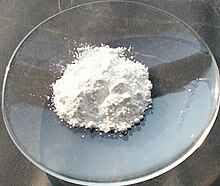산화 아연
보이기

| |
| 이름 | |
|---|---|
| 별칭
Zinc white, calamine, philosopher's wool, Chinese white, flowers of zinc
| |
| 식별자 | |
3D 모델 (JSmol)
|
|
| ChEBI | |
| ChEMBL | |
| ChemSpider | |
| DrugBank | |
| ECHA InfoCard | 100.013.839 |
| EC 번호 |
|
| 13738 | |
| KEGG | |
PubChem CID
|
|
| RTECS 번호 |
|
| UNII | |
| UN 번호 | 3077 |
CompTox Dashboard (EPA)
|
|
| |
| |
| 성질 | |
| ZnO | |
| 몰 질량 | 81.406 g/mol[1] |
| 겉보기 | White solid[1] |
| 냄새 | Odorless |
| 밀도 | 5.606 g/cm3[1] |
| 녹는점 | 1,974 °C (3,585 °F; 2,247 K) (decomposes)[1][5] |
| 끓는점 | 2,360 °C (4,280 °F; 2,630 K) (decomposes) |
| 0.0004% (17.8 °C)[2] | |
| 띠간격 | 3.3 eV (direct) |
자화율 (χ)
|
−27.2·10−6 cm3/mol[3] |
굴절률 (nD)
|
n1=2.013, n2=2.029[4] |
| 구조[6] | |
| Wurtzite | |
| C6v4-P63mc | |
a = 3.2495 Å, c = 5.2069 Å
| |
단위 세포 화학식 (Z)
|
2 |
| Tetrahedral | |
| 열화학[7] | |
열용량 (C)
|
40.3 J·K−1mol−1 |
표준 몰 엔트로피 (S
|
43.7±0.4 J·K−1mol−1 |
표준 생성 엔탈피 (ΔfH⦵298)
|
-350.5±0.3 kJ mol−1 |
기브스 자유 에너지 (ΔfG˚)
|
-320.5 kJ mol−1 |
| 약리학 | |
| QA07XA91 (WHO) | |
| 위험 | |
| 물질 안전 보건 자료 | ICSC 0208 |
| GHS 그림문자 | 
|
| 신호어 | 경고 |
| H400, H401 | |
| P273, P391, P501 | |
| NFPA 704 (파이어 다이아몬드) | |
| 인화점 | 1,436 °C (2,617 °F; 1,709 K) |
| 반수 치사량 또는 반수 치사농도 (LD, LC): | |
LD50 (median dose)
|
240 mg/kg (intraperitoneal, rat)[8] 7950 mg/kg (rat, oral)[9] |
LC50 (median concentration)
|
2500 mg/m3 (mouse)[9] |
LCLo (lowest published)
|
2500 mg/m3 (guinea pig, 3–4 h)[9] |
| NIOSH (미국 건강 노출 한계): | |
PEL (허용)
|
TWA 5 mg/m3 (fume) TWA 15 mg/m3 (total dust) TWA 5 mg/m3 (resp dust)[2] |
REL (권장)
|
Dust: TWA 5 mg/m3 C 15 mg/m3 Fume: TWA 5 mg/m3 ST 10 mg/m3[2] |
IDLH (직접적 위험)
|
500 mg/m3[2] |
| 관련 화합물 | |
다른 음이온
|
Zinc sulfide Zinc selenide Zinc telluride |
다른 양이온
|
Cadmium oxide Mercury(II) oxide |
달리 명시된 경우를 제외하면, 표준상태(25 °C [77 °F], 100 kPa)에서 물질의 정보가 제공됨.
| |
산화 아연(酸化亞鉛, Zinc oxide)은 화학식 ZnO를 갖는 무기 화합물이다. 물에 용해되지 않은 흰색 고체이다. 산화 아연은 화장품, 식이 보충제, 고무, 플라스틱, 세라믹, 유리, 시멘트, 윤활유, 페인트, 연고, 접착제, 밀폐제, 색소, 음식, 배터리, 페라이트, 발화 지연제, 응급 처치 테이프 등 수많은 재료와 제품의 첨가제로서 사용된다. 천연 홍아연광으로서 자연적으로 발생한다.
같이 보기[편집]
각주[편집]
- ↑ 가 나 다 라 Haynes, p. 4.100
- ↑ 가 나 다 라 NIOSH Pocket Guide to Chemical Hazards. “#0675”. 미국 국립 직업안전위생연구소 (NIOSH).
- ↑ Haynes, p. 4.136
- ↑ Haynes, p. 4.144
- ↑ Takahashi, Kiyoshi; Yoshikawa, Akihiko; Sandhu, Adarsh (2007). 《Wide bandgap semiconductors: fundamental properties and modern photonic and electronic devices》. Springer. 357쪽. ISBN 978-3-540-47234-6.
- ↑ Haynes, p. 4.152
- ↑ Haynes, pp. 5.3, 5.16
- ↑ Zinc oxide. Chem.sis.nlm.nih.gov. Retrieved on 2015-11-17.
- ↑ 가 나 다 “Zinc oxide”. 《Immediately Dangerous to Life and Health Concentrations (IDLH)》. National Institute for Occupational Safety and Health (NIOSH).
외부 링크[편집]
- Zincite properties
- International Chemical Safety Card 0208.
- NIOSH Pocket Guide to Chemical Hazards.
- 산화 아연 - Pesticide Properties DataBase (PPDB)
- Zinc white pigment at ColourLex

